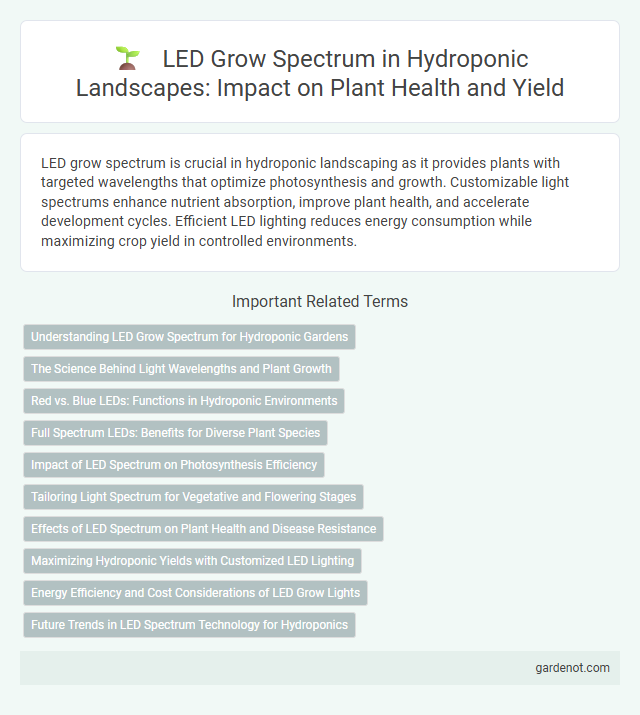LED grow spectrum is crucial in hydroponic landscaping as it provides plants with targeted wavelengths that optimize photosynthesis and growth. Customizable light spectrums enhance nutrient absorption, improve plant health, and accelerate development cycles. Efficient LED lighting reduces energy consumption while maximizing crop yield in controlled environments.
Understanding LED Grow Spectrum for Hydroponic Gardens
LED grow lights designed for hydroponic gardens emit specific wavelengths within the visible spectrum, primarily focused on blue (400-500 nm) and red (600-700 nm) light, which are crucial for photosynthesis and plant growth. Understanding the balance of these spectrums allows for optimized chlorophyll absorption, enhancing vegetative growth and flowering stages in hydroponic systems. Tailoring LED spectra to the plant species and growth phase increases energy efficiency and promotes healthier, faster crop yields.
The Science Behind Light Wavelengths and Plant Growth
LED grow lights emit specific wavelengths within the blue (400-500 nm) and red (600-700 nm) light spectrum, which are essential for photosynthesis and chlorophyll production in hydroponic landscapes. Blue light regulates vegetative growth and leaf development, while red light stimulates flowering and fruiting stages, optimizing plant yield and health. Tailoring LED spectra to crop-specific light absorption peaks enhances energy efficiency and maximizes photosynthetic efficiency in controlled hydroponic environments.
Red vs. Blue LEDs: Functions in Hydroponic Environments
Red LEDs in hydroponic landscapes promote flowering and fruiting by targeting the photosynthesis process during the blooming stage. Blue LEDs enhance vegetative growth by stimulating chlorophyll production and leaf development, essential for early plant structure. Balancing red and blue light spectra optimizes plant health and yield in controlled hydroponic systems.
Full Spectrum LEDs: Benefits for Diverse Plant Species
Full Spectrum LEDs provide a balanced light output that closely mimics natural sunlight, essential for photosynthesis in a wide range of hydroponic plants. These LEDs enhance growth, flowering, and fruiting by delivering optimal wavelengths including blue, red, and far-red light. Utilizing full spectrum LED grow lights improves plant health and yield across diverse species, from leafy greens to flowering crops.
Impact of LED Spectrum on Photosynthesis Efficiency
LED grow lights with a tailored spectrum significantly enhance photosynthesis efficiency by providing plants with specific wavelengths, primarily in the blue (400-500 nm) and red (600-700 nm) ranges, which are critical for chlorophyll absorption. Optimizing the LED spectrum can accelerate chlorophyll activity, improve energy use efficiency, and boost biomass production in hydroponic systems. Studies indicate that a balanced red-to-blue light ratio maximizes photosynthetic rates, leading to healthier plant growth and higher yields in controlled environment agriculture.
Tailoring Light Spectrum for Vegetative and Flowering Stages
Optimizing LED grow light spectra tailored for hydroponic landscapes enhances plant growth by matching light wavelengths to specific stages. Blue light (400-500 nm) promotes robust vegetative development, while red light (600-700 nm) accelerates flowering and fruiting phases. Customizable full-spectrum LEDs enable precise control, improving photosynthesis efficiency and crop yield in hydroponic systems.
Effects of LED Spectrum on Plant Health and Disease Resistance
LED grow light spectrum significantly influences plant health by optimizing photosynthesis and enhancing nutrient uptake, leading to robust growth and higher yields. Specific wavelengths such as blue and red light regulate plant morphology and stimulate the synthesis of secondary metabolites, improving disease resistance. Tailoring the LED spectrum can reduce pathogen susceptibility by boosting plants' innate immune responses and stress tolerance.
Maximizing Hydroponic Yields with Customized LED Lighting
Customized LED grow spectrum tailored for hydroponic landscapes maximizes photosynthesis and growth efficiency by providing targeted wavelengths such as blue (400-500 nm) and red (600-700 nm) light. Optimizing these spectral bands enhances chlorophyll absorption and accelerates plant development, directly increasing crop yields and quality in controlled environments. Advanced LED systems enable precise spectral adjustments, resulting in energy-efficient growth cycles and superior biomass production.
Energy Efficiency and Cost Considerations of LED Grow Lights
LED grow lights designed for hydroponic landscapes optimize the light spectrum to enhance photosynthesis while minimizing energy consumption, significantly reducing electricity costs compared to traditional HPS and MH lighting systems. Energy-efficient diodes emit targeted wavelengths in the blue and red spectrum, which are crucial for plant growth stages, ensuring maximum yield per watt and extending the life of the lighting equipment. Initial investment in high-quality LED grow lights is offset by lower operational costs, minimal heat output, and reduced maintenance requirements, making them a cost-effective solution for sustainable indoor horticulture.
Future Trends in LED Spectrum Technology for Hydroponics
Future trends in LED spectrum technology for hydroponics include the development of dynamic full-spectrum LEDs that mimic natural sunlight, enhancing plant growth efficiency and yield. Advances in tunable spectra enable growers to customize light wavelengths to specific crop stages, optimizing photosynthesis and secondary metabolite production. Integration of smart sensors and AI-driven controls further refines light delivery, reducing energy consumption and maximizing hydroponic system productivity.
LED grow spectrum Infographic

 gardenot.com
gardenot.com